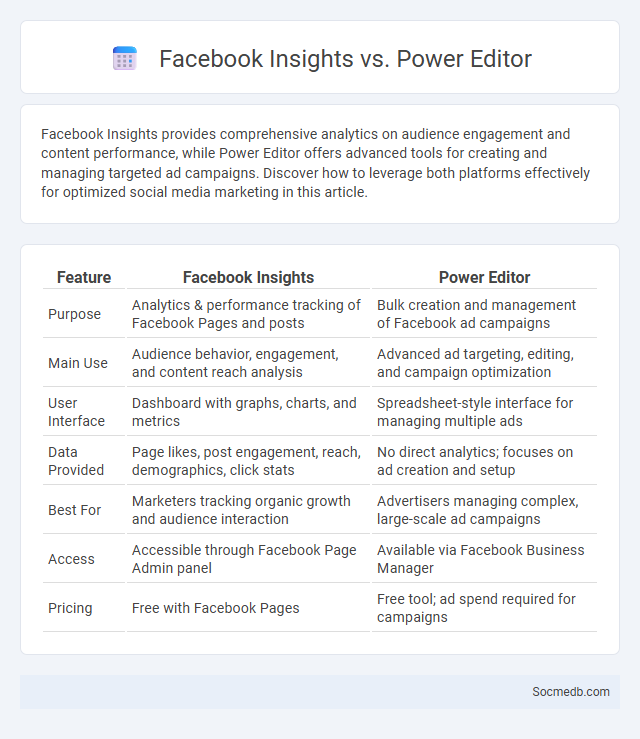
Photo illustration: Facebook Insights vs Power Editor
Facebook Insights provides comprehensive analytics on audience engagement and content performance, while Power Editor offers advanced tools for creating and managing targeted ad campaigns. Discover how to leverage both platforms effectively for optimized social media marketing in this article.
Table of Comparison
| Feature | Facebook Insights | Power Editor |
|---|---|---|
| Purpose | Analytics & performance tracking of Facebook Pages and posts | Bulk creation and management of Facebook ad campaigns |
| Main Use | Audience behavior, engagement, and content reach analysis | Advanced ad targeting, editing, and campaign optimization |
| User Interface | Dashboard with graphs, charts, and metrics | Spreadsheet-style interface for managing multiple ads |
| Data Provided | Page likes, post engagement, reach, demographics, click stats | No direct analytics; focuses on ad creation and setup |
| Best For | Marketers tracking organic growth and audience interaction | Advertisers managing complex, large-scale ad campaigns |
| Access | Accessible through Facebook Page Admin panel | Available via Facebook Business Manager |
| Pricing | Free with Facebook Pages | Free tool; ad spend required for campaigns |
Overview of Facebook Analytics Tools
Facebook Analytics tools provide in-depth insights into user behavior, engagement metrics, and conversion tracking across your social media campaigns. These tools enable businesses to analyze demographic data, track customer journeys, and optimize content performance for better ROI. Understanding Facebook Analytics helps you make data-driven decisions to enhance your marketing strategy and increase audience reach.
What is Facebook Insights?
Facebook Insights is a powerful analytics tool that provides detailed metrics about your page's performance, audience engagement, and content reach. It helps you understand how your posts, videos, and ads are performing by offering data on user demographics, page views, clicks, and interaction rates. By leveraging Facebook Insights, you can optimize your social media strategy to better connect with your audience and improve your content's effectiveness.
Key Features of Facebook Insights
Facebook Insights offers comprehensive analytics on your page's performance, including user demographics, post engagement metrics, and reach statistics. These key features enable You to track the effectiveness of your content by providing real-time data on likes, shares, comments, and follower growth. Utilizing this detailed information helps optimize your social media strategy for better audience targeting and improved overall engagement.
Understanding Facebook Power Editor
Facebook Power Editor is a robust advertising tool designed specifically for managing large or complex campaigns on Facebook. It enables advertisers to create, edit, and optimize multiple ads efficiently through bulk editing features and advanced targeting options. Utilizing power editor enhances campaign precision by allowing detailed audience segmentation, bid control, and comprehensive performance tracking.
Core Capabilities of Power Editor
Power Editor streamlines the management of complex ad campaigns with advanced targeting options, bulk editing features, and detailed performance analytics. It enables precise audience segmentation, creative asset optimization, and real-time budget adjustments to maximize ROI. Integration with Facebook's advertising infrastructure ensures seamless campaign deployment across multiple platforms and devices.
Comparing Facebook Insights and Power Editor
Facebook Insights offers comprehensive analytics on page performance, audience demographics, post reach, and engagement metrics, enabling marketers to track the effectiveness of their content and audience interactions. Power Editor provides advanced ad creation and bulk editing tools designed for managing complex Facebook advertising campaigns, allowing precise targeting, budget allocation, and A/B testing. While Facebook Insights focuses on analyzing user engagement data, Power Editor emphasizes optimized ad campaign management and execution on the Facebook platform.
Strengths and Limitations of Each Tool
Social media platforms each offer unique strengths, such as Facebook's robust community-building features and LinkedIn's powerful professional networking capabilities. However, limitations include Instagram's prioritization of visual content that may exclude text-heavy information and Twitter's character limit restricting detailed discussions. Understanding these platform-specific strengths and weaknesses is crucial for optimizing engagement and communication strategies.
How to Choose the Right Analytics Tool
Selecting the right social media analytics tool hinges on evaluating your specific goals, such as tracking engagement, measuring ROI, or understanding audience demographics. Consider features like real-time data visualization, multi-platform integration, and sentiment analysis capabilities to ensure comprehensive insights. Empower your marketing strategy by choosing a tool that aligns with your budget, technical expertise, and scalability needs.
Use Cases: When to Use Each Tool
Social media platforms serve distinct purposes based on your goals and target audience. Use Instagram for visually-driven content to engage younger demographics, LinkedIn for professional networking and B2B marketing, and Twitter for real-time updates and customer service interactions. Your choice of tool should align with your content type, audience behavior, and desired engagement outcomes to maximize impact.
Final Thoughts: Facebook Analytics Solutions
Facebook Analytics solutions provide comprehensive insights into user behavior, engagement patterns, and conversion metrics, enabling businesses to optimize their social media strategies effectively. Advanced features include audience segmentation, funnel analysis, and real-time data tracking that facilitate targeted marketing efforts and improved ROI. Leveraging these tools helps companies enhance customer experiences, refine content strategies, and drive growth through data-driven decision-making.
 socmedb.com
socmedb.com